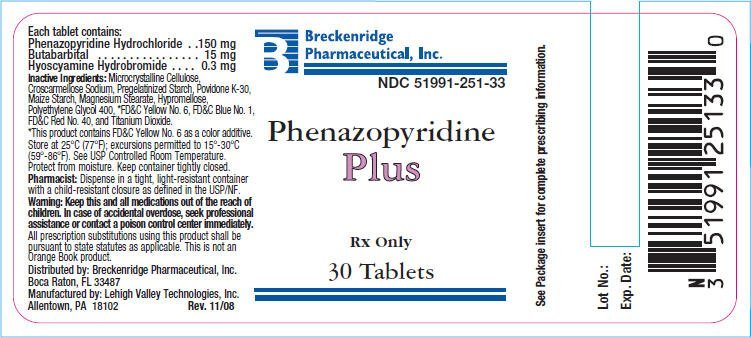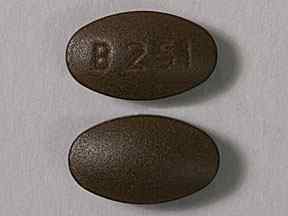Phenazopyridine Plus Prescribing Information
Package insert / product label
Generic name: phenazopyridine hydrochloride, butabarbital, and hyoscyamine hydrobromide
Dosage form: tablet, coated
Drug class: Urinary antispasmodics
Medically reviewed by Drugs.com. Last updated on Mar 25, 2024.
On This Page
Phenazopyridine Plus Description
Each Phenazopyridine Plus Tablet contains:
| Phenazopyridine Hydrochloride | 150 mg |
| Butabarbital | 15 mg |
| Hyoscyamine Hydrobromide | 0.3 mg |
Inactive Ingredients: Microcrystalline Cellulose, Croscarmellose Sodium, Pregelatinized Starch, Povidone K-30, Maize Starch, Magnesium Stearate, Hypromellose, Polyethylene Glycol 400, 1FD&C Yellow No. 6, FD&C Blue No. 1, FD&C Red No. 40 and Titanium Dioxide.
- 1
- This product contains FD&C Yellow No. 6 as a color additive.
Phenazopyridine Plus - Clinical Pharmacology
Phenazopyridine Plus relieves lower urinary symptoms of pain, frequency, urgency, burning, and dysuria, arising from inflammation of the urothelium, the mucosal lining of the lower urinary tract.
Lower urinary tract pain can cause reflex spasm of the detrusor. Pain and spasm are often aggravated by apprehension to promote a pain-spasm-apprehension cycle. Each of the three pharmacologic components of Phenazopyridine Plus acts against a phase of this cycle.
Phenazopyridine hydrochloride, excreted in the urine, is a topical analgesic for the relief of pain and discomfort.
Hyoscyamine hydrobromide, a parasympatholytic, acts to relieve detrusor muscle spasm. Butabarbital, a short-to-intermediate acting sedative, helps to allay associated anxiety and apprehension.
Indications and Usage for Phenazopyridine Plus
Phenazopyridine Plus is indicated for the symptomatic relief of pain, burning, frequency, urgency and dysuria, particularly when accompanied by the detrusor muscle spasm and apprehension.
These symptoms may arise from infection, trauma, surgery, endoscopic procedures, or the passage of sounds or catheters.
Therapy with Phenazopyridine Plus does not interfere with antibacterial therapy and can help to relieve symptoms of pain and discomfort before definitive treatment is effective. The use of Phenazopyridine Plus for symptomatic relief should not delay definitive diagnosis and treatment. Treatment of a urinary tract infection with Phenazopyridine Plus should not exceed 2 days because there is a lack of evidence that the combined administration of phenazopyridine hydrochloride and an antibacterial provides greater benefit than administration of the antibacterial alone after 2 days. (See DOSAGE AND ADMINISTRATION Section)
In the absence of infection, Phenazopyridine Plus may be the only medication required.
Contraindications
Phenazopyridine Plus should not be used in patients who have previously exhibited hypersensitivity to any component. The use of Phenazopyridine Plus is contraindicated in patients with renal or hepatic insufficiency, glaucoma, bladder neck obstruction, porphyria.
Warnings
Drowsiness or dizziness may occur. Patients should be instructed to use caution in driving or operating machinery.
Not to be used by persons having glaucoma or excessive pressure within the eye, by elderly persons (where undiagnosed glaucoma or excessive pressure within the eye occurs most frequently), or by children under 6 years of age, unless directed by a physician. Discontinue use if blurring of vision, rapid pulse, or dizziness occurs. Do not exceed recommended dosage. Not for frequent or prolonged use. If dryness of the mouth occurs, decrease dosage. If eye pain occurs, discontinue use and see your physician immediately as this may indicate undiagnosed glaucoma.
Precautions
General
A yellowish tinge of the skin or sclera may indicate accumulation due to impaired renal excretion of phenazopyridine hydrochloride and the need to discontinue therapy.
The decline in renal function associated with advanced age should be kept in mind.
Information for Patients
Phenazopyridine Hydrochloride produces an orange to red color in the urine and may stain fabric. Staining of contact lenses has been reported. Butabarbital may cause drowsiness or dizziness; patients should be instructed to use caution in driving or operating machinery.
Laboratory Test Interactions
Due to its properties as an azo dye, phenazopyridine hydrochloride may interfere with urinalysis based on spectrometry or color reactions.
Carcinogenesis, Mutagenesis, Impairment of Fertility
Phenazopyridine Plus has not undergone adequate studies relating to carcinogenesis, mutagenesis, or impairment of fertility, however the component phenazopyridine hydrochloride has induced neoplasia in rats (large intestine) and mice (liver). Although no association between phenazopyridine hydrochloride and human neoplasia has been reported, adequate epidemiological studies along these lines have not been conducted.
Pregnancy Category C
Animal reproduction studies have not been conducted with Phenazopyridine Plus. It is also not known whether Phenazopyridine Plus can cause fetal harm when administered to a pregnant woman or can affect reproduction capacity. Phenazopyridine Plus should be given to a pregnant woman only if clearly needed.
Adverse Reactions/Side Effects
Headache, rash, pruritus and occasional gastrointestinal disturbance. Methemoglobinemia, hemolytic anemia, renal and hepatic toxicity have been described for phenazopyridine, usually at overdose levels (see OVERDOSAGE section). An anaphylactoid-like reaction has been described.
Hyoscyamine hydrobromide is an atropinic drug that may produce adverse effects characteristic of this class of drugs. Dry mouth, drowsiness or dizziness is noted in more than one-third of patients (and may occur in half of the patients of older age groups). Other atropine-like effects such as blurred vision may occur. There may be occasional gastrointestinal disturbances.
Butabarbital is a short-to-intermediate acting barbiturate which has the potential for adverse reactions attributable to barbiturates.
Overdosage
Phenazopyridine Plus is a combination of three active drugs and the overdosage can be expected to show the effects related to each ingredient. Management includes the usual measures to empty the stomach by emesis or lavage, administration of a charcoal slurry, and supportive measures as needed.
Toxicity and management suggestions relating to the individual ingredients are as follows:
Phenazopyridine Hydrochloride
Exceeding the recommended dose in patients with good renal function or administering the usual dose to patients with impaired renal function (common in elderly patients), may lead to increased serum levels and toxic reactions. Methemoglobinemia generally follows a massive, acute overdose. Methylene blue, 1 to 2 mg/kg body weight intravenously, should cause prompt reduction of the methemoglobinemia and disappearance of the cyanosis which is an aid in diagnosis. Oxidative Heinz body hemolytic anemia may also occur, and "bite cells" (degmacytes) may be present in a chronic overdosage situation. Red blood cell G-6-PD deficiency may predispose to hemolysis. Renal and hepatic impairment and occasional failure, usually due to hypersensitivity, may also occur.
Hyoscyamine Hydrobromide
Overdosage of hyoscyamine, a form of atropine, will cause dilated pupils, blurred vision, rapid pulse, increased intraocular tension, hot, dry, red skin, dry mouth, disorientation, delirium, fever, convulsions, and coma. As an antidote, physostigmine salicylate may be given IV slowly. Dilute 1 mg in 5 mL of saline and use 1 mL of this dilution in children. Repeat every five minutes as needed up to a total of 2 mg in children, or 6 mg in adults every 30 minutes.
How is Phenazopyridine Plus supplied
Phenazopyridine Plus tablets are dark brown, coated, imprinted B-251 and are supplied in bottles of 30, NDC 51991-251-33.
Warning: Keep this and all medications out of the reach of children. In case of accidental overdose seek professional assistance or contact a poison control center immediately.
Store at 25°C (77°F); excursions permitted to 15°-30°C (59°-86°F). See USP Controlled Room Temperature.
Pharmacist: Dispense in a tight, light-resistant container with a child-resistant closure as defined in the USP/NF.
| PHENAZOPYRIDINE PLUS
phenazopyridine hydrochloride, butabarbital, and hyoscyamine hydrobromide tablet, coated |
||||||||||||||||||||||||||
|
||||||||||||||||||||||||||
|
||||||||||||||||||||||||||
|
||||||||||||||||||||||||||
|
||||||||||||||||||||||||||
|
||||||||||||||||||||||||||
|
||||||||||||||||||||||||||
| Labeler - Breckenridge Pharmaceutical, Inc. (150554335) |
| Establishment | |||
| Name | Address | ID/FEI | Business Operations |
|---|---|---|---|
| Lehigh Valley Technologies | 113290444 | MANUFACTURE | |


